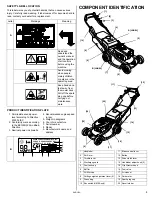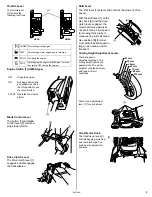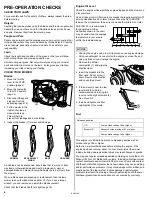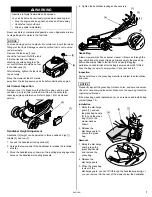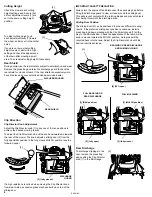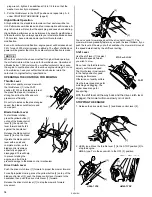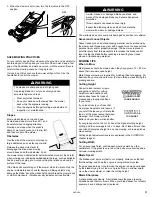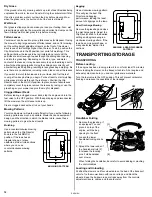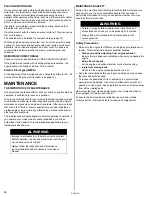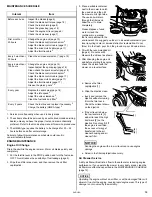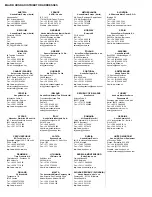
6
ENGLISH
PRE-OPERATION CHECKS
CHECK YOUR LAWN
For your safety and for the safety of others, always inspect the area
before mowing.
Objects
Anything that can be picked up by the blades and thrown is a potential
hazard to you and others. Look for things like stones, sticks, bones,
and wire. Remove them from the mowing area.
People and Pets
People and animals near the mowing area can move into your path or
into a position where they could be struck by thrown objects. Clear the
area of people, especially children, and pets. Their safety is your
responsibility.
Lawn
Check the length and condition of the grass, so that you will know
what cutting height and mowing speed to use.
Avoid mowing wet grass. Not only will wet grass clog your mower
deck and collect in clumps on the lawn, it also gives poor traction,
increasing your risk of losing your footing.
CHECK YOUR MOWER
Blades
1. Move the throttle
lever to the STOP
position (page 4).
2. Move the fuel valve
to the OFF position
(page 4).
3. Disconnect the spark
plug cap from the
spark plug (page 16).
4. Tilt the mower to the
right so that the air
cleaner side is up.
This will help to
prevent fuel leakage and hard starting.
5. Inspect the blades [1] for wear and damage.
A dull blade can be sharpened, but a blade that is worn out, bent,
cracked, or otherwise damaged must be replaced. A worn or
damaged blade can break, causing blade pieces to be thrown from
the mower.
When a blade needs sharpening or replacement, take the lawn
mower to an authorized Honda dealer. Or, if you have a torque
wrench, you can remove and install the blades yourself.
Check that the blade bolts [2] are tight (page 18).
Engine Oil Level
Check the engine oil level with the engine stopped and the mower on
a level surface.
Use 4-stroke motor oil that meets or exceeds the requirements for API
service classification SJ or later. Always check the API SERVICE
label on the oil container to be sure it includes the letters SJ or later.
SAE 10W-30 is recommended
for general use. Other
viscosities shown in the chart
may be used when the average
temperature in your area is
within the indicated range.
NOTICE
• Running the engine with a low oil level can cause engine damage.
•
Using nondetergent oil can shorten the engine’s service life, and
using 2-stroke oil can damage the engine
.
1. Remove the oil filler
cap/dipstick [1], and wipe the
dipstick clean.
2. Insert the dipstick into the
filler neck. Do not screw it
down. Remove the dipstick
and check the oil level.
3. If the oil level is near the low
level mark [3], add the
recommended oil to bring the
level up to the high limit mark [2].
Do not overfill.
4. Install and tighten the filler
cap/dipstick [1] securely.
Fuel
This engine is certified to operate on unleaded gasoline with an
octane rating of 86 or higher.
Refuel in a well-ventilated area before starting the engine. If the
engine has been running, allow it to cool. Never refuel the mower
inside a building where gasoline fumes may reach flames or sparks.
You may use regular unleaded gasoline containing no more than 10%
Ethanol (E10) or 5% Methanol by volume. In addition, Methanol must
contain cosolvents and corrosion inhibitors. Use of fuels with content
of Ethanol or Methanol greater than shown above may cause starting
and/or performance problems. It may also damage metal, rubber, and
plastic parts of the fuel system. Engine damage or performance
problems that result from using a fuel with percentages of Ethanol or
Methanol greater than shown above are not covered by warranty.
[1]
[2]
NORMAL
EXCESSIVELY
WORN
BENT
CRACKED
Unleaded gasoline
U.S.
Pump octane rating of 86 or higher
Except U.S.
Research octane rating of 91 or higher
Pump octane rating of 86 or higher
–20
0
20
40
60
80
100° F
–30 –20 –10
0
10
20
30
40° C
[1]
[1]
[2]
[3]
HXE.book Page 6 Monday, August 6, 2007 10:44 AM
Содержание HRX537HMEA
Страница 22: ...Printed on Recycled Paper ...



